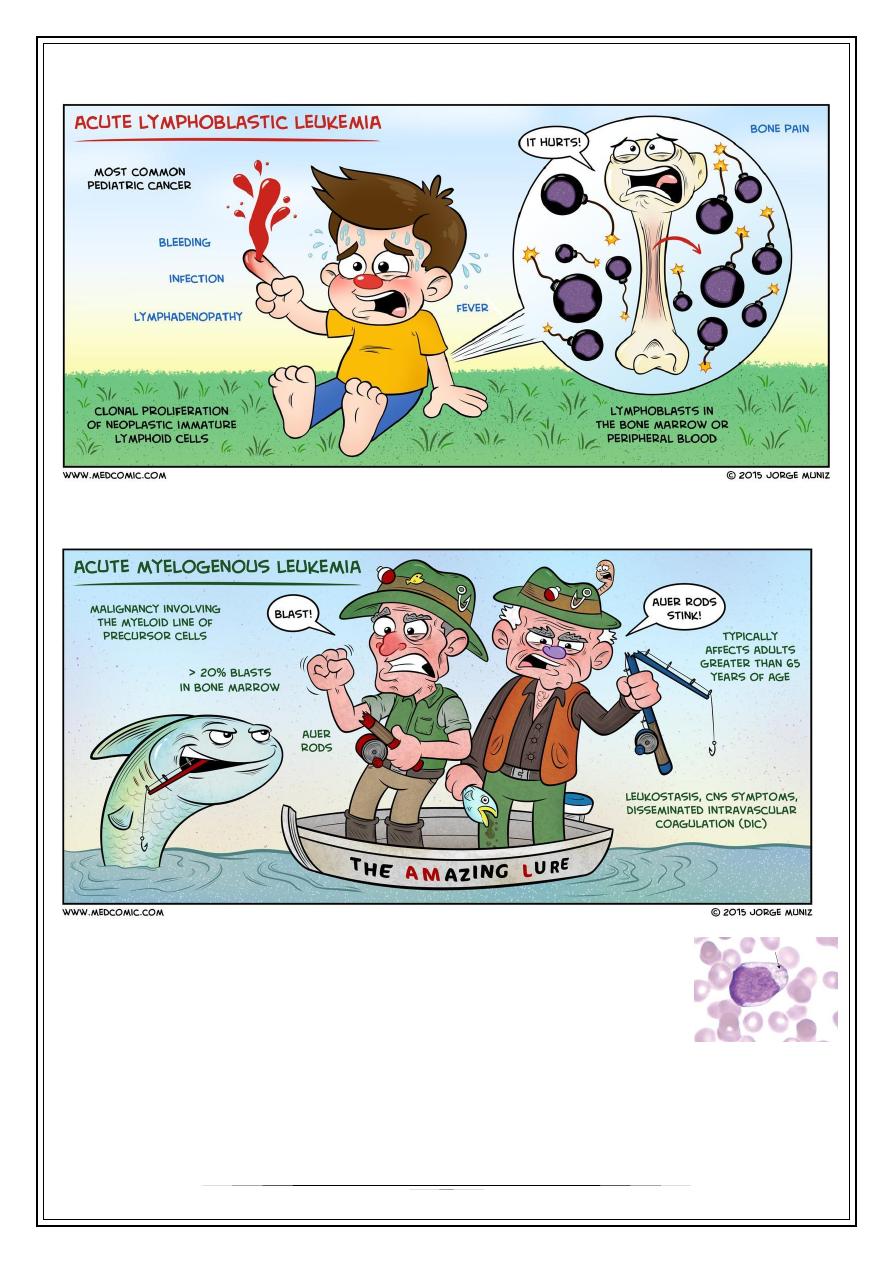
Fifth Stage
Internal Medicine
Dr. Aamer – Lecture 5
1
Acute Leukemia 's
A Case:
•
Dyspnea
o
(You think at first it is respiratory/cardiology problem, but their examinations revealed
normal chest!)
•
Pallor at face
•
Wet purpura in mouth
•
Splenomegaly
So, there is defect in RBC (pallor), Platelets (purpura). i.e. 2 of 3 of bone marrow
objectives, so there is bone marrow failure.
What is next?
•
Blood film:
o
Large abnormal primitive cells (Blasts)
▪
Normally, those blasts should not be present in peripheral blood.
•
CBC:
o
Anemia (Pallor)
o
Neutropenia (Fever due to infections)
o
Thrombocytopenia (Bleeding)
i.e. (Failure of production of RBC's, Platelets, and normal WBC).
So, this is
Acute Leukemia
!
Acute leukemia is a clonal malignant disorder due to proliferation of abnormal cells (that
fail to mature), results in failure of production of normal cells (Bone marrow failure).
Classifications
Classification of leukemias are: Acute and Chronic
(depending on time/speed of division of cells).
Classification of Acute leukemia:
•
Acute myeloid leukemia AML (affect myeloid
series), usually attacks adult & old age groups.
•
Acute lymphoblastic leukemia ALL (affect lymphoid series), usually attacks
pediatric age group.

2
Acute lymphoblastic Leukemia (ALL):
Acute Myeloid Leukemia (AML):
Auer rods are found in blood film/ Bone biopsy of AML.
•
It is diagnostic, Pathognomonic, Specific for AML.
Types: There are types of AML (M0-M7), each has specific signs:
M2 : Chloroma:-presents as a mass lesion ‘tumor of leukemic cells’
M3 : DIC
M4/M5 : Infiltration of soft tissues, gum infiltration, skin deposits, meningeal
involvement

3
Other investigations:
Bone marrow aspirate: Hypercellular & blast cells (> 20%).
Cytochemistry: Special stains to differentiate AML from ALL.
Management
(When you see pallor (anemia), send for blood film, not a blood transfusion request!)
Treatment is by ABCDE:
Allopurinol (Xanthine oxidase inhibitor for excessive uric acid)
Blood and platelet
Conazol:fluconazol
Dextrose water (fluid)
Empirical antibiotic
Special situation (NF):
ANC (absolute neutrophilic count) normally is 1,500 cells/ml
3
An Acute leukemia patient with ANC < 0.500 cell/ml
3
+ Fever (> 38°C)
Neutropenic Fever
(very important)
.
•
In its management: NEVER give antipyretic (fever is defense mechanism,
don't suppress it). So, give:
o
Anti-pseudomonal (Gentamicin/Cefipime) +
o
Anti MRSA (vancomycin) +
o
Beta-lactam (broad spectrum penicillin/meropenem) +
o
Anti-fungal.
That’s why we are scared from hyperthermia (fever). But, we fear more from hypothermia! (no
defense mechanism), so give more attention.
Acute promyelocytic leukemia (APL)
Is special type of acute myeloid leukemia, it is the M3 type of AML.
3 things to know about:
•
DIC (bleeding, commonest cause of death is CNS bleeding).
•
Needs platelets and fresh frozen plasma (Counter the DIC)
•
Diagnosis of APL by:
o
CBC
o
Bone marrow aspirate
o
Translocation T15:17

4
Management by:
•
ATRA (all-trans retinoic acid)
•
Arsenic trioxide
It is the most malignant serious type of Acute leukemia. But it is managed simply
without chemotherapy! With complete cure rate (80%).
Thank you,,,
Some Notes were written from students…
Some Review questions:
Acute promyelocytic leukemia:
a. Gum hypertrophy
b. DIC
c. Chloroma
d. None
Extramedullary involvement:
a. AML-M1
b. AML-M3
c. AML-M7
d. AML-M4
Diagnosis of ALL in bone marrow requires:
a. 15% blasts
b. 20% basts
c. 25% blasts
d. 30% blasts
Microscopic examination of a patient peripheral blood smear shows many blasts with Auer
rods, WHAT is the diagnosis?
